Enlargement countries - statistics on living conditions
Data from April 2023.
Planned article update: May 2024.
Highlights
Income distribution was more equal in 2021 in all Western Balkans than it had been in 2016, as measured by the income quintile share ratio.
On the basis of the most recent data available, the share of the population at risk of poverty after social transfers in the Western Balkans and Türkiye ranged from 21.2% in Serbia to 27.9% in Kosovo. In the EU in 2021 it was 16.8%.
In 2021, the proportion of people aged 18-59 years that lived in households with very low work intensity in the Western Balkans and Türkiye ranged from 11.6% in Albania (2020 data) to 38.6 % in Kosovo (2018 data). This ratio was estimated at 9.4% in the EU.
Proportion of the population at risk of poverty after transfers, 2021
This article is part of an online publication and provides information on a range of statistics related to living conditions in the Western Balkans and Türkiye and compares this with the corresponding data for the European Union (EU). Within this region, Bosnia and Herzegovina, Montenegro, North Macedonia, Albania, Serbia and Türkiye are candidate countries, while Kosovo* has the status of potential candidate.
Data for Georgia, Moldova and Ukraine, granted candidate status or European perspective by the European Council in June 2022, are not included in this article; Statistics Explained articles on the European Neighbourhood Policy-East countries are available here.
The article includes information relating to income distribution, the risk of poverty (before and after social transfers), the contribution of social transfers to median equivalised disposable income, the proportion of persons who are living in households with very low work intensity, as well as health and social protection expenditure.
* This designation is without prejudice to positions on status, and is in line with UNSCR 1244/1999 and the ICJ Opinion on the Kosovo Declaration of Independence.
Full article
Income distribution
The income quintile share ratio, also known as the S80/S20 ratio, is a measure of the inequality of income distribution. It is calculated as the ratio of total income received by the 20 % of the population with the highest income (the top quintile) to that received by the 20 % of the population with the lowest income (the bottom quintile). Incomes are equivalised to take account of the varying composition of households.
Figure 1 shows that the income of the top population quintile in all Western Balkans and Türkiye lay between close to 6 and 14 times the size of the income of the bottom population quintile in the year for which the latest data is available. In 2020 (no 2021 data), in North Macedonia and Albania the ratio of income inequality was the same 5.9 in each country; in Montenegro (2020) and in Serbia it was 6.0 in each country; and in Türkiye it was 8.8. Kosovo recorded the highest ratio, at 14.2 (2020 data). Between 2016 and 2021, the income quintile share ratio fell in North Macedonia (between 2016 and 2020) by 0.8 percentage points (pp); in Montenegro (between 2016 and 2020) and in Kosovo (between 2018 and 2020) by 1.4 pp in each country; in Albania (between 2017 and 2020) by 1.6 pp and in Serbia by 5.1 pp. The ratio increased somewhat in Türkiye by 0.2 pp. In the EU, the income of the top population quintile was estimated 5.0 times the size of the income of the bottom population quintile in 2021, having remained almost unchanged (-0.2 nbsp;pp) from 2016.
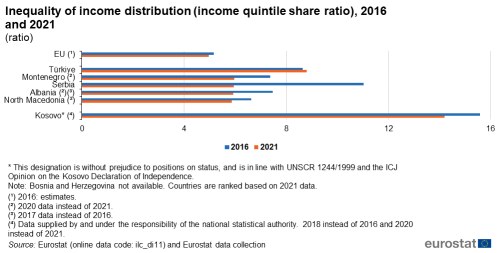
(ratio)
Source: Eurostat (ilc_di11) and Eurostat data collection
The Gini coefficient is an alternative measure of income inequality. It shows the extent to which all incomes within the population differ from the average income: the closer the coefficient is to 100 the less equal are the incomes, while the closer it is to 0 the more equal are the incomes. As was already observed for the income quintile share ratio, Gini coefficients for all the Western Balkans and Türkiye were higher than in the EU, suggesting that income disparities were greater in the WBT countries. In 2021 in Western Balkans and Türkiye, the coefficient ranged from 31.4 in North Macedonia (2020 data) to 44.2 in Kosovo (2018 data). The Gini coefficient in Montenegro (2020 data) was 32.9; Albania, 33.2; Serbia, 33.3; and in Türkiye, 42.6. There was no data available for Bosnia and Herzegovina. In Figure 2, only four of the Western Balkans and Türkiye have data for both a recent year and another year approximately 10 years earlier. North Macedonia reported a decrease in the Gini coefficient by 7.4 points over 2012-2020 from 38.8 to 31.4. In Montenegro the Gini coefficient dropped by 5.6 points between 2013 and 2020 and in Serbia by 4.7 points between 2013 and 2021, while Türkiye was essentially unchanged, reporting a marginal decrease from 43.3 in 2011 to 42.6 in 2021. In the EU, the Gini coefficient in 2021 was 30.1 slightly down from the value recorded in 2011, which had been 30.5.
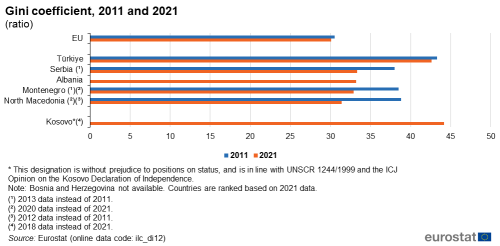
(ratio)
Source: Eurostat (ilc_di12) and Eurostat data collection
Monetary poverty
The poverty threshold shown in Table 1 is set at 60 % of the national median equivalised disposable income after social transfers. The total net income of each household is calculated by adding together the income received by all the members of the household from all sources. For each person, the equivalised total net income is calculated as the household’s total net income divided by the equivalised household size. This is generally based on the modified OECD scale: a weight of 1.0 for the first adult, 0.5 for other persons aged 14 years or over who are living in the household and 0.3 for each child aged less than 14 years.
The poverty threshold is shown as a monthly income, ranging in 2021 among the Western Balkans and Türkiye for which data are available from the equivalent of EUR 103 in Kosovo (2018 data) to EUR 205 in Serbia. No data was available for Bosnia and Herzegovina.
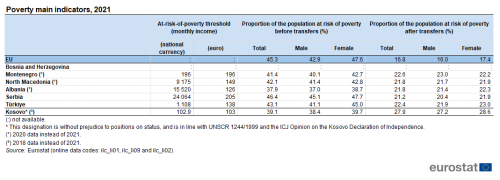
Source: Eurostat (ilc_li02), (ilc_li09) and (ilc_li01) and Eurostat data collection
The at-risk-of-poverty rate is the proportion of the population with an equivalised disposable income below the poverty threshold. This indicator can be calculated either before social transfers or after social transfers. The difference between the two reflects the proportion of the population moved above the threshold as a result of receiving social transfers. Social transfers cover the social help given through benefits such as: old-age and survivors’ (widows’ and widowers’) pensions; unemployment, family-related, sickness and invalidity, education-related and other benefits; housing allowances; and social assistance.
As the poverty threshold is set independently for each WBT country, the indicator reflects low income in comparison with other residents in the same economy. This does not necessarily imply an extremely low standard of living. In 2021 in the Western Balkans and Türkiye for which data is available, the at-risk-of-poverty rates before transfers disaggregated by gender were in every case higher for women than for men. The highest difference was recorded in Türkiye: 41.1 % for men and 45.0 % for women. Serbia and Montenegro were close behind: 45.1 % for men and 47.7 % for women and 40.1 % for men and 42.7 % for women, respectively. The difference was smaller in Albania (2020 data): 37.0 % for men and 38.7 % for women; in North Macedonia (2020 data): 41.4 % for men and 42.8 % for women); and in Kosovo (2018 data): 38.4 % for men and 39.7 % for women. The disaggregation for the EU was 42.9 % for men and 47.6 % for women, a greater difference than in any of the candidate countries or potential candidates. No data is available for Bosnia and Herzegovina. The most recent data from the Western Balkans and Türkiye on the proportions of the population at risk of poverty after social transfers ranged from 21.2 % in Serbia to 27.9 % in Kosovo (2018 data). All were higher than in the EU, where the proportion in 2021was estimated at 16.8 %. Montenegro was the only country of the WTB with a higher proportion of men than of women, the difference being -0.8 pp. Elsewhere, the proportion of women was higher than of men by between +0.2 pp in North Macedonia and +1.5 pp in Serbia. No data is available for Bosnia and Herzegovina. In the EU in 2021, the proportion of men at risk of poverty after social transfers was 16.0 %, while for women the figure was 17.4 %.
The analysis of the contribution of social transfers to median equivalised disposable income can illustrate the impact and redistributive effects of welfare policies. These transfers cover assistance that is given by central, state or local institutional units and include, among others, pensions, unemployment benefits, sickness and invalidity benefits, housing allowances, social assistance and tax rebates.
Figure 3 shows the overall impact of social transfers. The data distinguish transfers for pensions from other transfers such as social security benefits and social assistance, which have the aim of alleviating or reducing the risk of poverty. The statistics are reported in terms of purchasing power standards (PPS) per inhabitant. This measure normalises the level of transfers against median equivalised disposable income, permitting comparisons between countries with different standards of living.
In the Western Balkans and Türkiye for which data is available, the value of social transfers varied considerably. The largest total transfers were observed in Serbia, Montenegro (2020 data) and Türkiye, where social transfers including pensions increased the median equivalised disposable income by PPS 2 374, 1 949 and 1 914 per inhabitant, respectively. At the other end of the scale, Kosovo (2018 data) recorded the lowest transfers, at PPS 778 per inhabitant, followed by Albania (2020 data) with PPS 846 and North Macedonia (2020 data) with PPS 1 791 per inhabitant. There is no data for Bosnia and Herzegovina. The highest social transfers other than pensions were recorded in Serbia at PPS 719 per inhabitant, followed by Montenegro (2020 data) at PPS 596 per inhabitant. Kosovo (2018 data) recorded the lowest level of transfers with PPS 113 per inhabitant, followed by Albania (2020 data), North Macedonia (2020 data), and Türkiye with PPS 154, 163 and 225 per inhabitant, respectively.
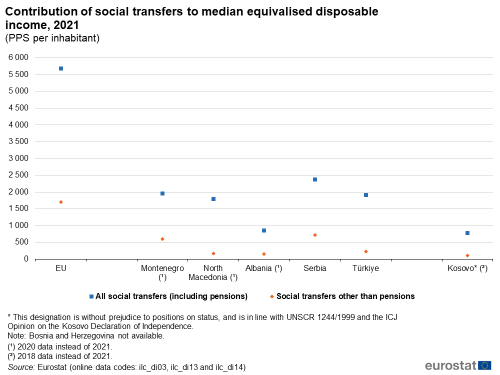
(PPS per inhabitant)
Source: Eurostat (ilc_di03), (ilc_di13) and (ilc_di14)
Households with very low work intensity
Persons living in households with low work intensity are those aged 0-59 living in households where the adults aged 18-59, excluding students, have worked 20 % or less of their total work potential during the past year. The work intensity of a household is the ratio of the total number of months that all working-age household members have worked during the income reference year to the total number of months the same household members could theoretically have worked in the same period. The indicator is based on the EU statistics on income and living conditions (EU-SILC). The two indicators presented in Figure 4 concern different subpopulations: people aged 0-17 years, who are considered as dependent children; and those of working age, defined as 18-59 years.
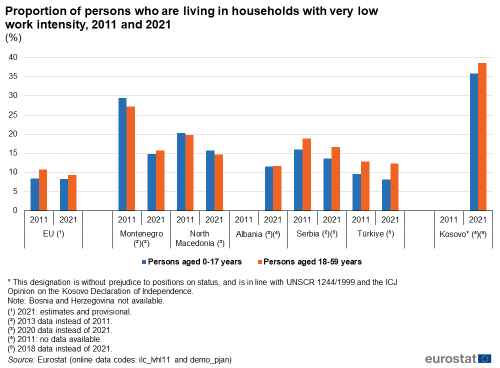
(%)
Source: Eurostat (ilc_lvhl11) and (demo_pjan) and Eurostat data collection
The proportion of persons who were living in households with very low work intensity in the Western Balkans and Türkiye in 2021 was the lowest in Türkiye for the category of persons aged 0-17 and second lowest for the category of persons aged 18-59 years , 8.1 % and 12.3 % , respectively. In Albania (2020 data), the shares were 11.6 % for both age categories. In North Macedonia (2020 data), there were 15.8 % of younger people living in households with very low work intensity and 14.7 % of working age people. In Serbia (2020 data), 13.6 % of people aged 0-17 years were living in households with very low work intensity, as were 16.7 % of people of working age. In Montenegro (2020 data), 14.8 % of people aged 0-17 and 15.7 % of those 18-59 years were living in households with very low work intensity. In Kosovo (2018 data), the proportions were much higher; there were 35.8 % of younger people living in households with very low work intensity and 38.6 % of working age people. There is no data available for Bosnia and Herzegovina.
For both age groups, the proportions of people living in households with very low work intensity in Montenegro (2013-2020), North Macedonia, Serbia (2013-2020) and Türkiye were lower in 2020 (no 2021 data) than in 2011. In Montenegro the proportion declined by 14.6 pp for the younger age group and by 11.5 pp for the working age population. In North Macedonia, the decline was by 4.6 pp for the population aged 0-17 and by 5.2 pp for people of working age. In Serbia the decline was smaller by 2.3 pp for the population aged 0-17 and by 2.2 pp for people of working age. In Türkiye the shares decreased by 1.4 pp for the younger age group and by 0.5 pp for the working age population. In the EU, there was an estimated decrease of 0.2 pp in the proportion of young people living in households with very low work intensity over 2011-2021 and a decrease of 1.4 pp for persons aged 18-59 years.
Health and social protection expenditure
Total expenditure on health concerns total current expenditure on health and investment, regardless of the source of funds. It covers: curative and rehabilitative care (in-patient care, day cases, out-patient and home care); services of long-term nursing care (in-patient, day cases and home care); ancillary services to health care; medical goods dispensed to out-patients; services of prevention and public health; health administration and health insurance. The level of expenditure on health relative to gross domestic product (GDP) is shown in Figure 5 and Table 2. Bosnia and Herzegovina is the only country of the Western Balkans and Türkiye where data is available. Health expenditure accounted for 9.8 % of the GDP of Bosnia and Herzegovina.
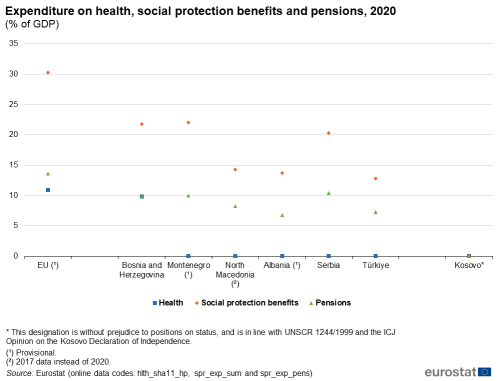
(% of GDP)
Source: Eurostat (hlth_sha11_hp), (spr_exp_sum) and (spr_exp_pens) and Eurostat data collection
Social protection expenditure comprises social protection benefits, administration costs and other expenditure. The data shown in Figure 5 and Table 2 only concern the benefits. Social benefits consist of transfers, in cash or in kind, by social protection schemes to households and individuals to relieve them of the burden of a defined set of risks or needs, provided that there is neither a simultaneous reciprocal nor an individual arrangement involved. The list of risks or needs is fixed as: sickness/health care; disability; old-age; survivors; family/children; unemployment; housing; and other social exclusion. Note that not all health expenditure falls within social protection expenditure.
In 2020, expenditure on social protection benefits in the five Western Balkans and Türkiye for which data are available was equivalent to less than one quarter of GDP. In Montenegro the ratio was 22.0 %; in Bosnia and Herzegovina 21.8 %; in Serbia (2018 data) 20.3 %; and in North Macedonia 14.3 %, in Albania 13.7 %. In Türkiye, the ratio was 12.8 % in 2020. The expenditure on social protection benefits in the EU in 2020 was estimated to be equivalent to more than one quarter of GDP at 30.3 %.
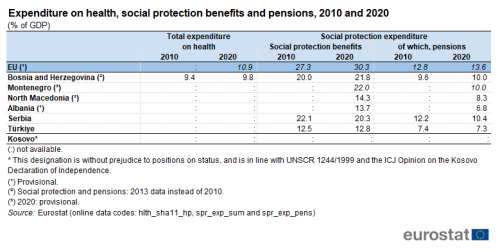
(% of GDP)
Source: Eurostat (hlth_sha11_hp), (spr_exp_sum) and (spr_exp_pens) and Eurostat data collection
The ratio of expenditure on social protection benefits to GDP, shown in Table 2, for the only WBT countries for which data are available for both 2010 and 2020, fell by 1.8 percentage points in Serbia over the period and increased by 1.8 percentage points in Bosnia and Herzegovina, while it increased only by 0.3 percentage points in Türkiye. In the EU, this ratio was 3.0 percentage points higher in 2020 than in 2010.
A large part of expenditure on social protection benefits consists of payments for pensions. The relative importance of this depends, among other factors, on the age structure of the population. Between 2010 and 2020, the ratio of social protection expenditure on pensions relative to GDP in Serbia decreased from 12.2 % in 2010 to 10.4 % in 2020, down 1.8 percentage points. Türkiye reported a marginal decrease of 0.1 percentage points between 2010 and 2020, from 7.4 % to 7.3 %, while Bosnia and Herzegovina reported a minor increase of 0.4 percentage points between 2010 and 2020, from 9.6 % to 10.0 %. The ratio social protection expenditure on pensions to GDP grew in the EU, from 12.8 % to 13.6 %. Data for other Western Balkans and Türkiye are not available for both years. Expenditure on pensions accounted for more than half of the total expenditure on social protection benefits in three out of six WBT countries for which recent data are available, ranging from 51.2 % in Serbia through 57.0 % in Türkiye to 58.0 % in North Macedonia. This share was less than half in Albania (49.6 %) Bosnia and Herzegovina (45.9 %), Montenegro (45.5. %). In the EU provisional expenditure on pensions accounted for 44.9 % of the total expenditure on social protection benefits in 2020.
Source data for tables and graphs
Data sources
The data used in this article are derived from EU statistics on income and living conditions (EU-SILC), data which are compiled annually and are the main source of statistics that measure income and living conditions in Europe.
Data for some of the enlargement countries (Albania and Türkiye) are collected for a wide range of indicators each year through a questionnaire that is sent by Eurostat to Western Balkans and Türkiye. A network of contacts has been established for updating these questionnaires, generally within the national statistical offices, but potentially including representatives of other data-producing organisations (for example, central banks or government ministries).
EU-SILC is an instrument that aims to collect timely and comparable data on income, poverty, social inclusion and living conditions, in both monetary and non-monetary terms. The data are generally collected for private households and household members. EU-SILC provides both cross-sectional data and longitudinal data (typically over a four-year period).
The legal basis for this data collection exercise is Regulation (EU) 2019/1700 of the European Parliament and of the Council of 10 October 2019 establishing a common framework for European statistics relating to persons and households, based on data at individual level collected from samples (Integrated European Social Statistics – IESS).
Information concerning the current statistical legislation on income and living conditions can be found here.
Currently, EU-SILC data are also available for the following candidate countries and potential candidate: Montenegro, North Macedonia, Serbia, Türkiye and Kosovo.
The European system of integrated social protection statistics (ESSPROS) is a common framework developed within the European Statistical System (ESS) that has been designed to provide a coherent comparison across European countries (27 EU Member States plus the United Kingdom, Iceland, Norway, Switzerland, Montenegro, North Macedonia, Serbia, Türkiye as well as Bosnia and Herzegovina) of social benefits to households and their financing, in terms of precisely defined risks or needs that refer to the ESSPROS functions: disability, sickness/health care, old-age, survivors, family/children, unemployment, housing and social exclusion. The legal basis for the data collection exercise is provided by Regulation (EC) No 458/2007 of the European Parliament and of the Council on the European system of integrated social protection statistics (ESSPROS). ESSPROS is composed of a core system that contains annual data from 1990 onwards on (gross) expenditures and receipts. In addition to the core system, one module on pension beneficiaries and one on net social benefits data are available.
More detailed information concerning the current statistical legislation on social protection can be found here.
Tables in this article use the following notation:
| Value in italics | data value is forecasted, provisional or estimated and is therefore likely to change; |
| : | not available. |
Context
Social protection systems are generally well-developed in the EU: they are designed to protect people (to some degree) against the risks and needs associated with unemployment, parental responsibilities, sickness/health care and invalidity/disability, the loss of a spouse or parent, old-age, housing and other forms of social exclusion.
The main policy framework in this field is the EU’s strategic agenda 2019-2024. The open method of coordination (Social OMC) for social protection and social inclusion aims to promote social cohesion and equality through adequate, accessible and financially sustainable social protection systems and social inclusion policies.
Through the Social OMC – and in collaboration with the Social Protection Committee – the EU provides a framework for national strategy development for social protection and social investment, as well as for coordinating policies between EU countries on issues relating to:
While basic principles and institutional frameworks for producing statistics are already in place, the enlargement countries are expected to increase progressively the volume and quality of their data and to transmit these data to Eurostat in the context of the EU enlargement process. EU standards in the field of statistics require the existence of a statistical infrastructure based on principles such as professional independence, impartiality, relevance, confidentiality of individual data and easy access to official statistics; they cover methodology, classifications and standards for production.
Eurostat has the responsibility to ensure that statistical production of the enlargement countries complies with the EU acquis in the field of statistics. To do so, Eurostat supports the national statistical offices and other producers of official statistics through a range of initiatives, such as pilot surveys, training courses, traineeships, study visits, workshops and seminars, and participation in meetings within the European Statistical System. The ultimate goal is the provision of harmonised, high-quality data that conforms to European and international standards.
Additional information on statistical cooperation with the enlargement countries is provided here.
Direct access to
- Ageing Europe - statistics on pensions, income and expenditure — online publication
- Living conditions in Europe - poverty and social exclusion — online publication
- Living conditions in Europe - income distribution and income inequality — online publication
- Enlargement countries — statistical overview — online publication
- Statistical cooperation — online publication
- Statistical books/pocketbooks
- Key figures on enlargement countries — 2019 edition
- Key figures on enlargement countries — 2017 edition
- Key figures on the enlargement countries — 2014 edition
- Factsheets
- Basic figures on the candidate countries and potential candidates — Factsheets — 2023 edition
- Basic figures on Western Balkans and Türkiye — Factsheets — 2022 edition
- Basic figures on enlargement countries — Factsheets — 2021 edition
- Leaflets
- Basic figures on enlargement countries — 2020 edition
- Basic figures on enlargement countries — 2019 edition
- Basic figures on enlargement countries — 2018 edition
- Basic figures on enlargement countries — 2016 edition
- Enlargement countries — Demographic statistics — 2015 edition
- Key figures on the enlargement countries — Population and social conditions — 2013 edition
- People at risk of poverty or social exclusion (Europe 2020 strategy) (ilc_pe)
- Income distribution and monetary poverty (ilc_ip)
- Living conditions (ilc_lv)
- Candidate countries and potential candidates (cpc) (ESMS metadata file — cpc_esms)
- Income and living conditions (ilc) (ESME metadata file — ilc)
- Working together, working better: a new framework for the open coordination of social protection and inclusion policies in the European Union (COM(2005) 706 final)
- Regulation of the European Parliament and of the Council (EC) 2019/1700 concerning Community statistics on income and living conditions (EU-SILC)
- Summaries of EU legislation: EU statistics on income and living conditions
- Regulation (EC) No 458/2007 of the European Parliament and of the Council on the European system of integrated social protection statistics (ESSPROS)
- Summaries of EU legislation: European system of integrated social protection statistics (ESSPROS)